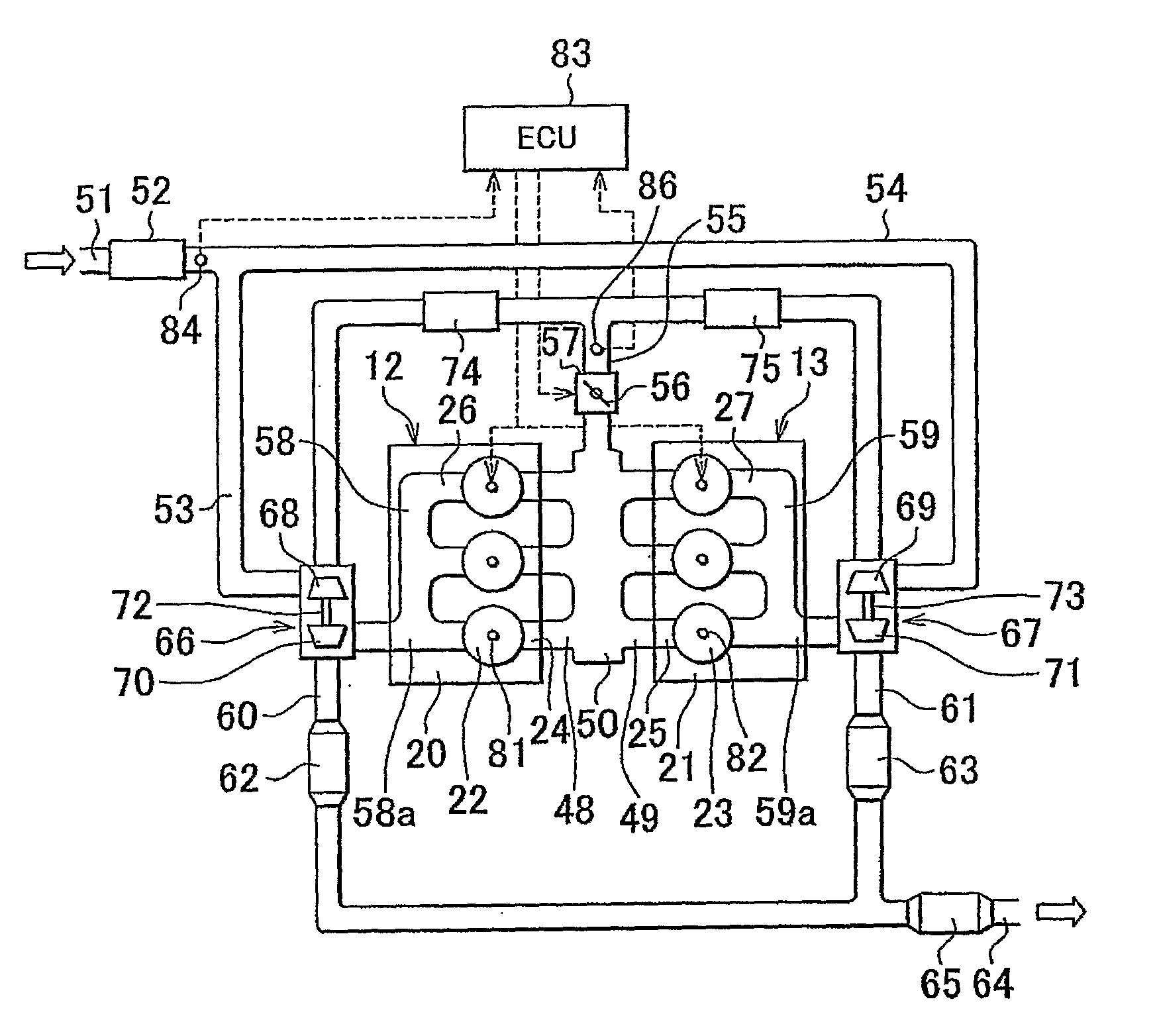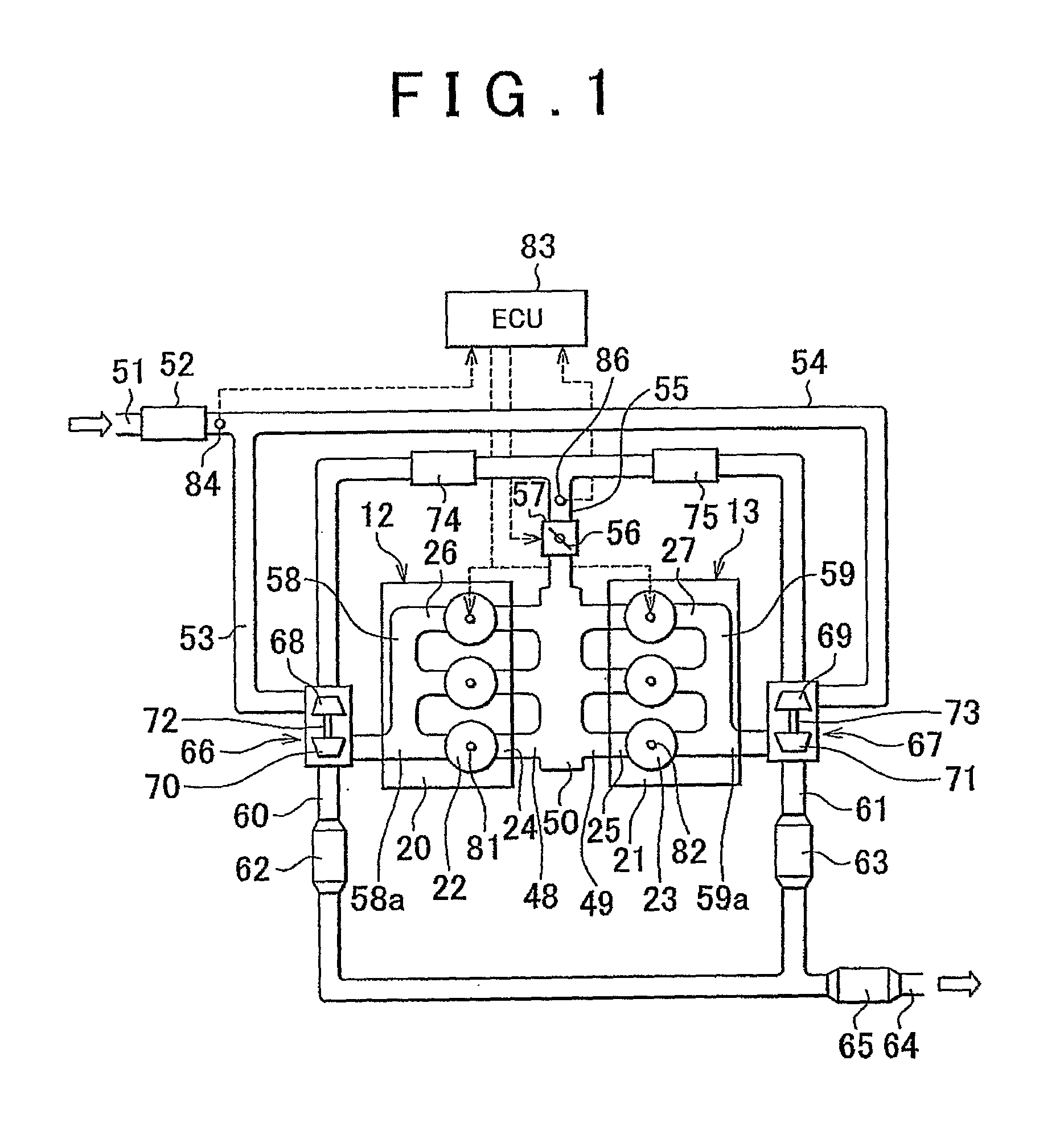Internal combustion engine and internal combustion engine control method
a technology of internal combustion engine and control method, which is applied in the direction of electric control, machines/engines, mechanical equipment, etc., can solve the problems of reducing torque, deteriorating driveability, and deteriorating driveability, and achieve the effect of improving driveability
- Summary
- Abstract
- Description
- Claims
- Application Information
AI Technical Summary
Benefits of technology
Problems solved by technology
Method used
Image
Examples
first embodiment
[0056]In the case where the engine is equipped with turbochargers as in the first embodiment, however, the following problem may occur upon switching of the combustion mode. Namely, when the combustion mode is switched between a non-supercharged stoichiometric combustion mode and a supercharged lean combustion mode, the boost pressure increases to a level higher than necessary due to an increase of the exhaust energy, and a stepped change (e.g., an abrupt reduction) in torque occurs upon the completion of the combustion mode switching control, resulting in deterioration of the driveability.
[0057]In the engine of the first embodiment, therefore, when the ECU 83 changes the combustion mode (the air / fuel ratio) from the non-supercharged stoichiometric combustion mode (the stoichiometric air / fuel ratio) to the supercharged lean combustion mode (a lean air / fuel ratio) while retarding the ignition timing, the ECU 83 keeps the retard amount of the ignition timing at a constant value if the...
second embodiment
[0104]As described above, the internal combustion engine of the second embodiment in the form of the V-type six-cylinder engine is provided with the turbochargers 66, 67 capable of compressing intake air and feeding the compressed air into the combustion chambers 22, 23, and the waste gate valves 103, 104 are mounted in the bypass pipes 101, 102 that bypass the turbines 70, 71. The ECU 83 is capable of switching the combustion mode from the supercharged lean combustion mode to the non-supercharged stoichiometric combustion mode, depending on the engine operating conditions. When switching from the supercharged lean combustion mode to the non-supercharged stoichiometric combustion mode, the ECU 83 retards the ignition timing, and increases the degree of opening of the waste gate valves 103, 104 in accordance with the amount of increase of the exhaust energy during the combustion mode switching control.
[0105]With the above arrangement, it is possible to prevent torque from increasing ...
third embodiment
[0119]In the third embodiment as described above, when the ECU 83 changes the combustion mode (the air / fuel ratio) from the non-supercharged stoichiometric combustion mode (the stoichiometric air / fuel ratio) to the supercharged lean combustion mode (a lean air / fuel ratio) while retarding the ignition timing, the ECU 83 determines whether the boost pressure detected by the boost pressure sensor 86 has become equal to or higher than the target boost pressure set in advance based on the operating conditions, and increases the degree of opening of the air bypass valves 113, 114 in accordance with the amount of increase of the boost pressure if it is determined that the boost pressure has become equal to or higher than the target boost pressure. However, when the ECU 83 changes the combustion mode (the air / fuel ratio) from the supercharged lean combustion mode (a lean air / fuel ratio) to the non-supercharged stoichiometric combustion mode (the stoichiometric air / fuel ratio) while retardin...
PUM
 Login to View More
Login to View More Abstract
Description
Claims
Application Information
 Login to View More
Login to View More - R&D
- Intellectual Property
- Life Sciences
- Materials
- Tech Scout
- Unparalleled Data Quality
- Higher Quality Content
- 60% Fewer Hallucinations
Browse by: Latest US Patents, China's latest patents, Technical Efficacy Thesaurus, Application Domain, Technology Topic, Popular Technical Reports.
© 2025 PatSnap. All rights reserved.Legal|Privacy policy|Modern Slavery Act Transparency Statement|Sitemap|About US| Contact US: help@patsnap.com



